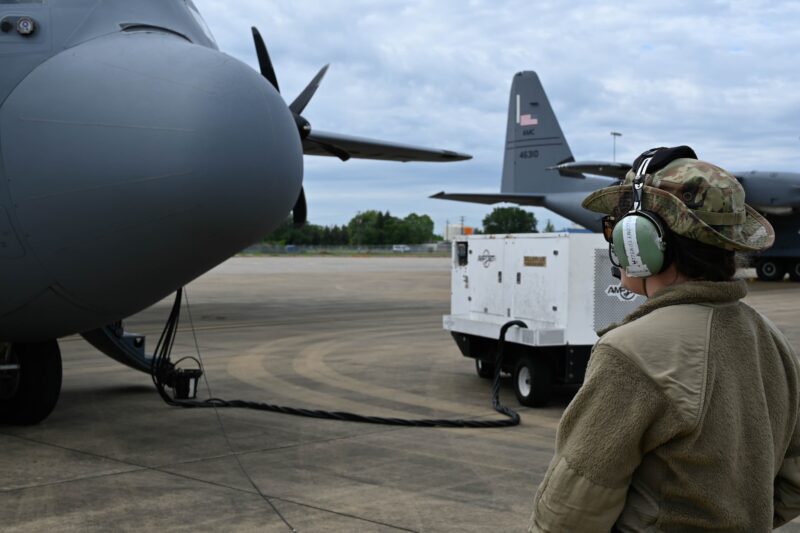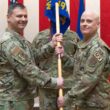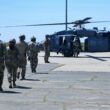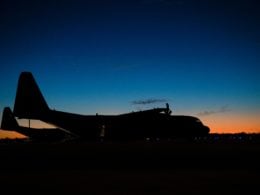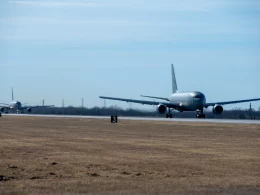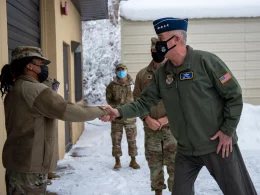LITTLE ROCK AIR FORCE BASE, Ark. —
The 19th Airlift Wing successfully completed the Green Flag Little Rock 23-07 exercise hosted by the 34th Combat Training Squadron at Alexandria International Airport, La., April 19 – 27, 2023.
The primary objective of GFLR is to support the Joint Readiness Training Center and provide training to the maximum number of airlift crews, mission planners and ground support elements in a simulated combat environment with an emphasis on Joint Force Integration.
The 19th AW’s six C-130J Super Hercules were accompanied by C-130Js from the Royal Canadian Air Force, U.S. Air Force C-17 Globemaster III’s and KC-46 Pegasus aircraft and their crews while participating in the exercise.
“This exercise was an excellent opportunity to work alongside our defense partner, Canada, to achieve our objectives,” said Maj. Jesse Lind, 41st Airlift Squadron pilot and ground mission commander for GFLR. “They were integrated in the exercise from planning to execution, sharing tactics, techniques and procedures, and lessons learned to further prepare for tomorrow’s fight.”
During GFLR the 41st AS conducted 82 missions with 110 sorties while transporting U.S. Army infantry, U.S. Air Force aeromedical evacuation personnel and various military cargo. All of which was accomplished while performing in complicated threat and airspace scenarios.
The exercise’s missions included personnel and cargo airdrops, austere landings, low-level tactical flying and engine running operations to on-load and off-load cargo. These missions took place 24 hours a day.
“This was the first GFLR involved in encapsulating all phases of Joint Forcible Entry to deploy an Army unit,” said Lind. “This means that we not only airdropped 1,253 Army paratroopers on an objective area to seize initial objectives, but we continued to support their efforts to stabilize and secure their lodgment by landing further personnel and equipment around the clock for a week.”
The event also tested survival, resistance, evasion and escape (SERE) skills with unannounced SERE events taking place throughout the exercise.
According to Lind, there was an expanded focus on ensuring crews were ready to face the risks associated with operating in a threat environment.
“One of our aircrews was chosen to simulate having to survive behind enemy lines,” said Lind. “What in previous exercises would have lasted several hours in the woods was expanded to several days surviving both in open waters and the wilderness.”
In addition to exercising the Joint capability of rapidly introducing forces into hostile environments to conduct operations, it provides Airmen with the opportunity to develop refinements to processes and procedures that can potentially enhance the effectiveness of real-world operations.
“Exercises like this let leadership know our readiness posture for tomorrows fight,” said Lind. “They also prepare us so we don’t get caught off guard by limitations and gives our ground crews and more junior members experience with training events that they don’t see every day.”
Green Flag is not just an exercise, it is just one component of a larger Joint training scenario conducted by the U.S. Army’s Joint Readiness Training Center and their objective is to validate a rotational training unit’s ability to achieve their assigned mission in defense of national objectives.
“GFLR is a validation event for the Army, but for us it served as an opportunity for us to practice for Air Mobility Command’s upcoming validation event—Mobility Guardian 2023,” said Lind.
Exercises of this magnitude are challenging, but provide abundant opportunities for training, learning and enhancing Joint Force capabilities. Vital training that is necessary to prepare for AMC’s premiere bi-annual mobility exercise, which is fully integrated into a variety of exercises in the USINDOPACOM’s theater, supporting eight Joint exercises and building interoperability with seven nations, scheduled to execute in the Indo-Pacific theater this summer.




